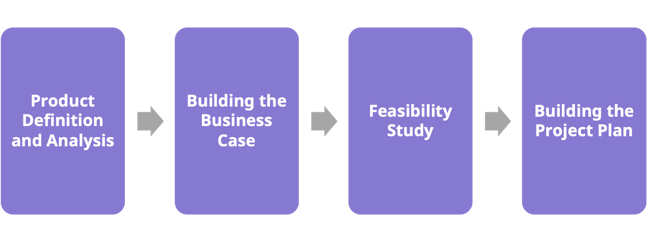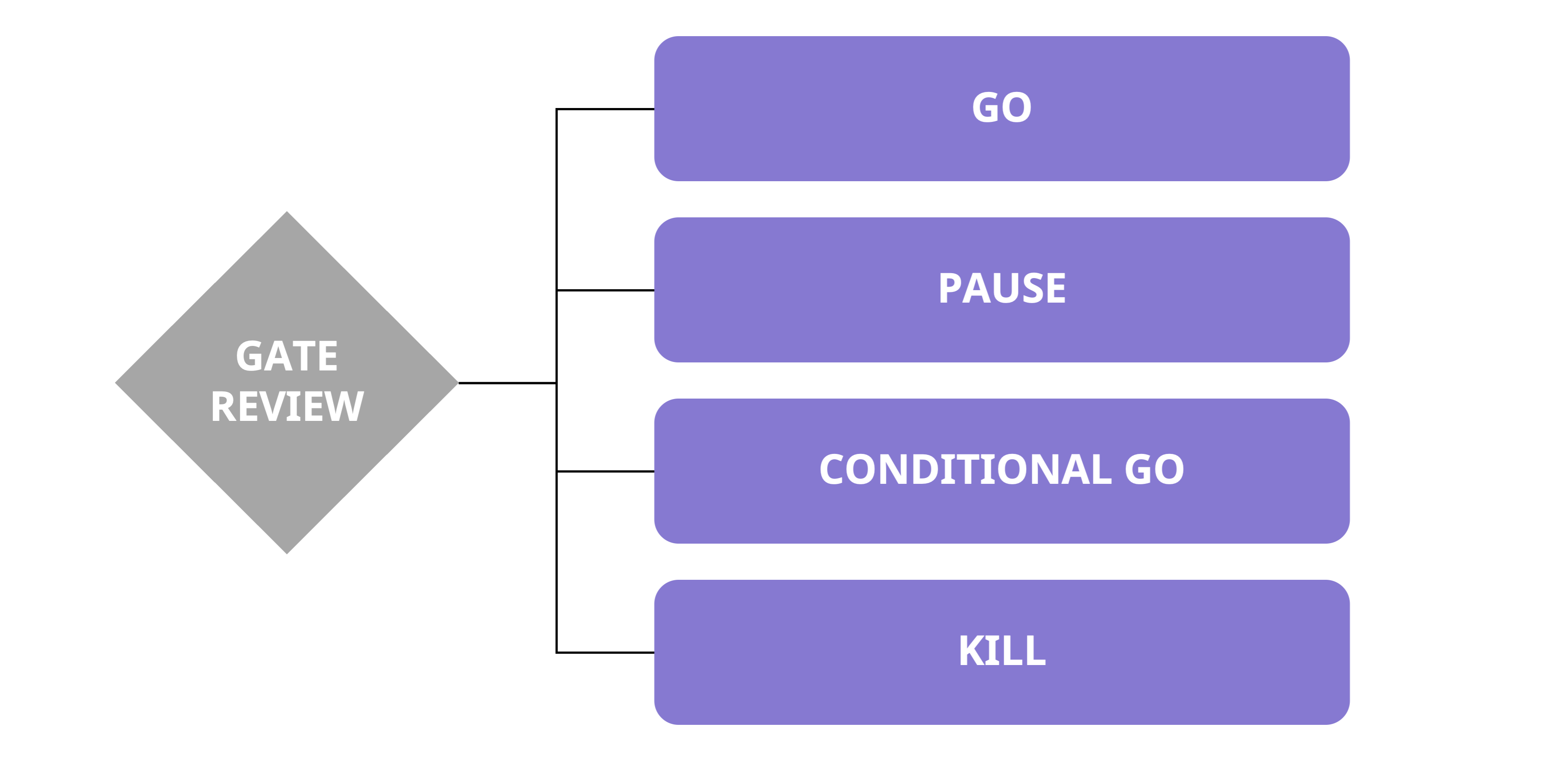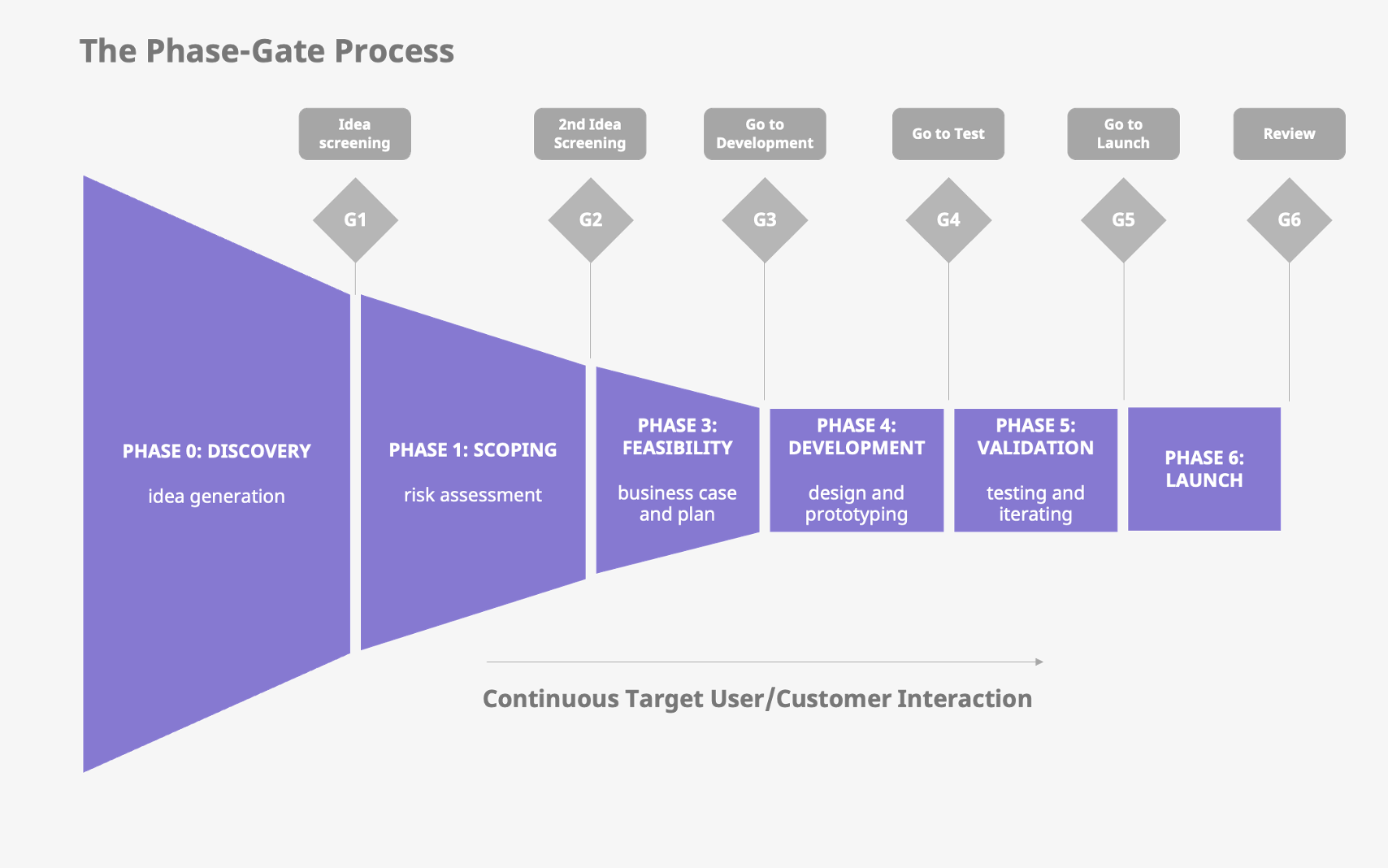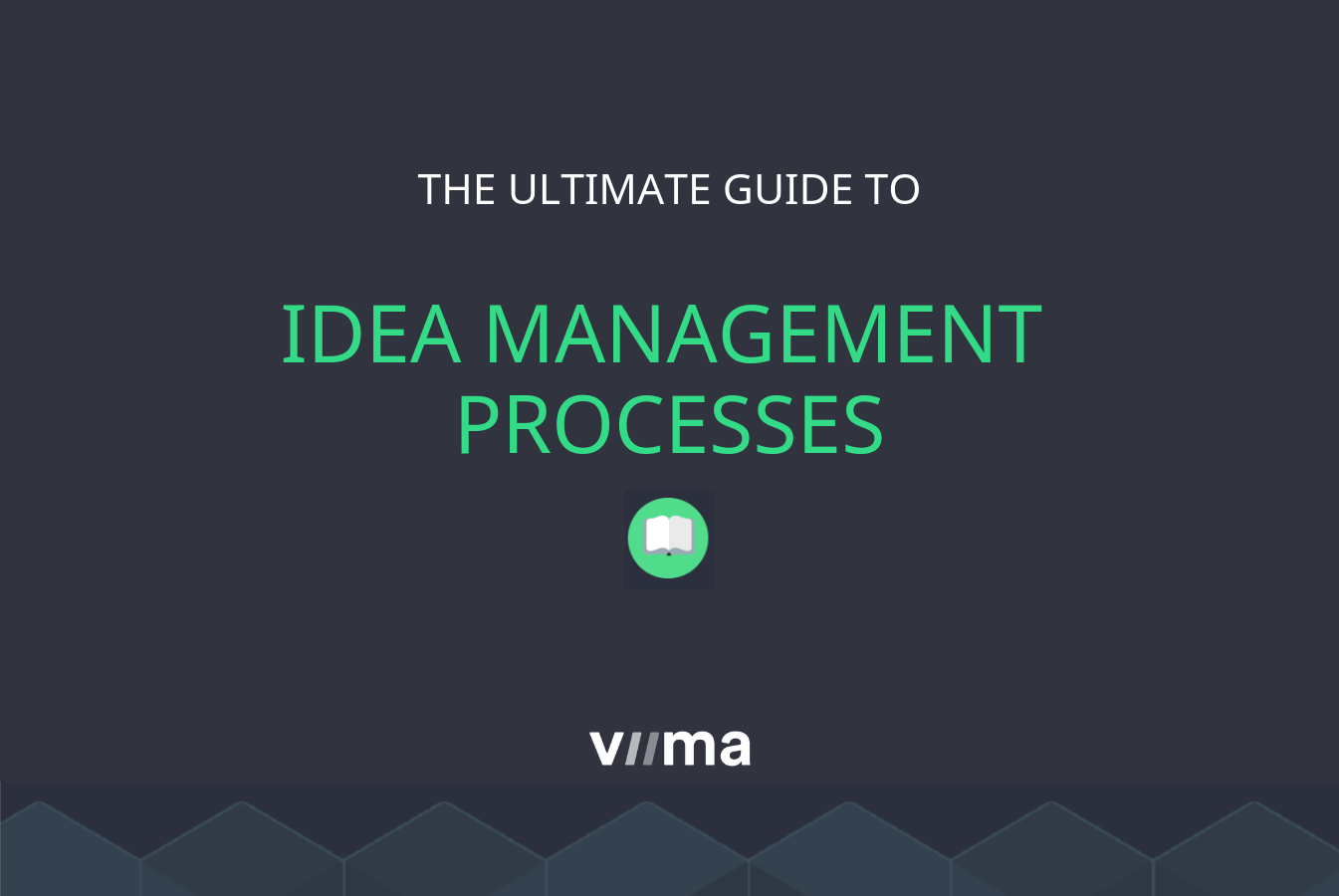The Ultimate Guide to the Phase-Gate Process
While improvisation might bring the zest to a comedy performance or to your Saturday night’s Bolognese sauce, in the world of innovation a systematic approach is the way to go. And the zest here is a fitting and well-thought-through innovation management process.
It has been a hot minute since we last covered the topic. So, for the New Year, we will dust off our knowledge and insights and share updated guides to innovation management techniques.
In this guide, we will take a deep dive into the Phase-Gate process, arguably one of the best-known innovation management techniques.
What is it, and why it might be just the right approach to innovation management for your organization? Let’s jump right into it.
Table of contents

What is the Phase-Gate Process?
A more linear, sequential approach such as the Phase-Gate process to product innovation and management isn’t all that new.
Already in the mid-20th century, engineering companies were adapting a segmented manufacturing journey with the aim of better allocating their budgets or shutting down projects that are failing to deliver expected results.
However, a refined version of the Phase-Gate process (under the name Stage-Gate© Discovery-to-Launch Process) was offered by Dr. Robert G. Cooper in the 1980s. It was originally introduced as a faster way to manage product innovation.
So, what exactly is the Phase-Gate process?
In short, it is a segmented (do-review) innovation management and New Product Development (NPD) technique. It is used to efficiently manage resources, prioritize initiatives, and lead the project from the early ideation steps, through development and prototyping to launch.
Cooper’s Stage-Gate process has a very specific and rigid structure, and while many use that term to refer to their management techniques, in reality, most organizations tweak the original structure and adapt it to their unique circumstances and ways of developing products.
Thus, any process that has a linear, segmented model with regular assessments and go/no-go decisions is commonly referred to as a Phase-Gate process.
How does it Work?
Since day one, the goal of the technique has been to divide a lengthy product development process into several well-defined steps (phases) to ease its evaluation along the way. Such an approach allowed managers to see whether the project is still on track to fulfill the promise of the initial idea or has it missed the perfect time to enter the market.
Just like with anything popular and well-known, the Phase-Gate process attracts a healthy amount of criticism. It is mainly criticized for its rigid structure which can stifle creativity since it is based on extensive research, detailed planning, and continuous double-checking. However, this strict structure and frequent check-ins are also the reason why the Phase-Gate is still popular, decades after its introduction.
Regular review processes allow organizations to identify and address issues early in the development stage. If any shortcomings would be discovered during the regular check-ins (gates), the project would be killed, paused, or sent back for a rework. In return, the elimination of weak projects would allow the organization to save time and money, as well as unlock more value by reallocating resources to more lucrative ideas.
Likewise, a project deemed valuable and promising would be green-lighted and would proceed to the next phase, be it prototyping, testing or launch.
At the end of the day, the Phase-Gate process gives an opportunity for the organization to manage the development of a product systematically and efficiently, minimizing risks, and ensuring that resources get allocated to the most viable projects, thus increasing the chances of the overall innovation portfolio being successful.
The objective of the Phase-Gate process is to minimize risks in product or service development, allocate resources more efficiently, and increase the overall chance of success for the innovation portfolio.
Who Can Benefit from Using the Phase-Gate Process?
The Phase-Gate process can be a great fit for big organizations where a hefty upfront investment (time /money) is typically needed to deliver a product to the market, or in industries where there are specific regulatory constraints.
For example, complicated projects like developing and manufacturing a new drug, or a smartphone device while difficult and requiring a very diligent, well-coordinated approach, are fundamentally predictable, hence they can be successfully planned out in advance and benefit from the Phase-Gate process.
So, common examples of industries where the process is used include the pharmaceutical sector, construction industry, electronics, manufacturing, and similar. Usually, as the applicable industries indicate, those organizations are quite large.
On the other hand, if you are running a low-risk project or a complex, disruptive initiative, the Phase-Gate process might become burdensome and too time-consuming.
A good example of low-risk cases might be any small incremental improvements to an existing product, a customer pre-ordering or committing to a contract, then part of the risk consideration is the customer's responsibility, and rigorous gatekeeping becomes counterproductive.
Complex projects, on the other hand, such as creating a completely new type of business, a disruptive product, etc. are all unpredictable. It means that you can’t know in advance how changing one thing will affect another, so it’s nearly impossible to plan in advance. For these situations, more iterative and agile methods are likely to win against the Phase-Gate technique.
Thus, it is important to know when to adapt the Phase-Gate process to your own projects and when to green-light small endeavors from the get-go and just see them unfold.
While its roots and main benefits come from and for NPD processes, any complicated and time-consuming project can benefit from a well-structured Phase-Gate approach.
Any complicated and time-consuming project can benefit from a well-structured Phase-Gate approach
Even in unpredictable projects, key ideas of the process can be useful, shifting focus on eliminating risks one at a time and granting funding in tiers as the team makes progress, not all at once.
To get a better understanding of what parts of the process could be used and when, let’s take a look at all its elements one by one.

The Structure of the Phase-Gate Process
To kick off the Phase-Gate process, you need to have an idea. It can derive from early-stage brainstorming sessions, a fruitful chat over coffee, or maybe even a well-planned ideation process. Either way, this idea-generation period in the Phase-Gate process is called the discovery phase or phase 0.
In an innovation process, the discovery focuses on identifying the right problem or opportunity to address. On top of all the brainstorming and creative thinking, it often includes a lot of field research.
Once you have the idea, you then work toward scoping it (phase 1), ensuring it is feasible (phase 2), developing (phase 3), testing and validating (phase 4), then finally launching it (phase 5). So, in total, the Phase-Gate process consists of six distinct idea development steps: discovery, scoping, feasibility, development, validation, and launch.
The Phase-Gate process consists of six distinct idea development steps: discovery, scoping, feasibility, development, validation, and launch
In addition, there are five continuous and one post-project review point - the so-called gates. Gates are pre-defined checkpoints where decision-makers assess the progress of the process and decide either to cancel the project or grant additional resources to it.

Thus, a review is necessary to harness the full value of your project. The gate review can also act as a short break for a difficult launch, pausing the development or sales process to implement fixes or improvements.
So, in short, the Phase-Gate process might look a little bit like this:
- Discovery phase: an innovation opportunity is discovered, and the initial idea is screened for the first time.
- Scoping phase: if the idea passes the first gate, the scope will be defined. The idea is thus refined into a proper concept and screened for the second time.
- Feasibility: accepted idea moves to the feasibility phase, where a business case is built, and the concept gets screened at the third gate.
- Development and Validation: the innovation’s first prototypes are created and evaluated, and testing takes place.
- Launch: when the innovation has been validated based on pre-defined criteria, it is launched to the market. After that, a post-launch review takes place
The above is a simplified version of a typical process. However, the Phase-Gate process can be molded to your unique needs, and many organizations indeed choose to do so.
But before we touch on that subject, let’s get a better understanding of each phase and the structure of the most common gates.
Discovery
First, to kick off the innovation process, you need ideas worth developing. In Phase-Gate, this step is called the discovery phase. Discovery creates a perfect environment for the ideation process, during which you and your team are generating and communicating ideas.
For NPD, where the Phase-Gate process is used the most, the discovery phase focuses on the problem or opportunity. Here, it is crucial to know what your potential customer's needs and wants are. So, for that purpose, an organization can employ a framework such as the Jobs To Be Done theory.
It is worth noting that one should not limit themselves to ideas from their team only. Suggestions can come from outside your organization too, they can be sourced from inter-departmental brainstorming sessions, market research, collecting feedback from customers, suppliers, product teams, etc.
.png?width=650&height=163&name=Copy%20of%20Slim%20banners%20(4).png)
Scoping
In short, during the discovery, you generate a good idea, and during the Scoping phase, you map out some of the key risks and hypotheses associated with the idea and turn it into a tangible concept that you could start to develop.
During this step, the initial feasibility is considered, and market research is conducted. The Scoping phase is an excellent time to utilize SWOT or PESTEL analysis.
During the Scoping phase, it is crucial to understand the current supply and demand in the market, to determine what can be offered.
However, not every good-sounding idea is worth developing and during the scoping phase, it should be evaluated based on the organization's priorities, not only the market fit.
Feasibility
The Feasibility phase (often referred to as Business Case or Business Viability) is the glue that pulls and holds your project together. In short, it is an important step of the Phase-Gate process, during which an actionable plan for the development of the product/service is created.
If your project gets the green light after this phase, it will move to the development step, thus use this time wisely and consider all “what ifs” in advance to avoid any possible hiccups.
The feasibility phase is complicated and time-consuming, and it is recommended to divide it into the following steps:

- Product definition and analysis: one of the first steps is to determine whether the product is desirable and whether it solves the earlier discovered problem. User research during this step can help answer such crucial questions as how to satisfy customers’ needs and according to those, what features should the product have. Both quantitative and qualitative research should be conducted (i.e., interviews, surveys, and focus groups). Additional market and competitive analyses also take place during this phase.
- Building the business case: a business case is a document that compares the project’s benefits against the costs, with a focus on whether the benefits truly outweigh the expenditure. It allows decision-makers to understand if the plan is realistic.
- Feasibility study: While your business case analyses whether a project should be done, the feasibility study evaluates whether it could be. And at its core, it answers the simple yet key question: in case of launch, will the outcomes of the project justify the cost needed to develop it?
- Building the project plan: your project plan will determine what, where, when, and by whom. Think of it as a schedule for your business plan, that overlooks all the steps that you will take to move through the Phase-Gate process. It covers resources needed to complete the project, estimating how much time it would take to develop, and test, and finally when to launch the product.
Development
The developing phase is meant to work on a “tangible” prototype of the new product or service. Design and development teams should work according to pre-set goals and clear KPIs. The SMART goals approach can be a useful tool to break down the process into actionable steps.
In addition to product/service development and design, it is time to focus on a marketing campaign and plan how to reach your target audience.
Early-stage (alpha- or lab-) testing might take place during the development phase. The ideal goal of this stage is to prepare an early working prototype, ready and set to go into the testing phase.
Validation
The goal of the Validation phase is naturally to validate your prototype and for that, testing takes place. It is important to determine whether the prototype delivers any value and did it really meet the needs and objectives defined in the earlier stages. This step is all about polishing the rough edges, testing marketing, and distribution channels, and testing processes around the product.
Early-stage testing took place in the previous phase, but now it is time to see the product in action and gather as much feedback as possible. You do not want to rush a half-operating, half-failing product to the launch phase hoping for the best. You want to be ahead of all the possible issues and during this phase, you should ensure the following tests are taking place:
- Near Testing: Run an in-house test involving people who are familiar with the product and process. During this test, the focus is set on finding any issues or bugs and eliminating them before the product hits the market or even before it moves to the beta-testing step.
- Field (Beta) Testing: This is the time for your project to leave its nest and get tested in a real-world setting. Typically, this testing involves your customers, partners or to play it super safe – internal staff that has never been part of the development process. The goal of beta testing is to see how testers are using the product, what features they like or find useless, and how much workload, wear and tear it can withhold. Flaws identified in this phase should get fixed.
- Market Testing: Now that you have a perfected product, and you have a better understanding of how your future customers will use it, it is time to utilize this knowledge to adjust your earlier set marketing plan. Test several different marketing scenarios, positioning and messaging alternatives, different price points, and channels to see which ones seem to work the best. There is a plethora of different things to test and methods to use and the right ones depend on your unique situation and the hypothesis you need to test.

Launch
The validation step gives a chance to make the final tweaks and fixes to the project and if it passes the post-validation review step, it successfully moves to the launch phase.
However, while it sounds simple on paper, the launch phase is the step where all of the departments meet and have to work in perfect sync. Alongside the marketing department working their magic and the knowledgeable sales team, you must ensure the following are in order too: volume of production, methods, and channels for customer acquisition and delivery.
One thing that is important to plan for the launch is customer support. You might exhaust all the means of testing the product pre-launch, yet you will never be able to 100% predict how it will really behave in the market. In case your product gets a lot of attention, be it good or bad, a knowledgeable and dedicated support team will eliminate possible bottlenecks.
With that said, the launch phase is a long journey away from those first, shy ideation steps you take in the discovery phase. Your initial idea will be analyzed and scrutinized under a magnifying glass during the full Phase-Gate cycle and it will have to pass several gates first.
What is a Gate Review Process?
Traditionally, a project managed with the Phase-Gate process will go through 4 control gates (Idea Screening, Second Screening, Go-to-Development, Go-to-Market Test) until reaching the final pre-launch gate – Launch. If during the final gate, the project gets approved and reaches the launch phase, the last thing that should be done is a post-launch Review, which could be considered as the final gate.
However, the Phase-Gate process can be adapted to the individual organization's needs and the number of gates can be increased. Or, if a company is using a simplified process for smaller scale projects – decreased. No matter which path you pick for your project, remember that the quality of your gates can determine the quality of your project.
The quality of the gate review process can determine the quality of the whole project.
Gatekeeping
Normally, people responsible for reviewing and gatekeeping the project depend on the organization’s size, type, and scope of the product. Usually, it is a cross-functional executive committee or a steering group.
In a nutshell, this group or person is responsible for ensuring that the project gets a green light to move forward or gets stopped. In addition, they provide feedback and guidance to the project development teams to help them identify risks and to avoid unnecessary mistakes.
For the gatekeeper, it is important to understand all practicalities around the project. While there is a budget to keep an eye on, the progress will be doomed if it’s just the numbers that get looked at. The gatekeeper needs to deeply understand the market, technology, and customers, not just compare business cases and pick the one with the bigger numbers.
Whether the organization assigns a committee or a single supervisor for the gate review process, the crucial part is to ensure that the gatekeeper is not directly related to the project (project sponsor, project manager), to avoid biased assessment.
During the gate review, resources, budget, KPIs, and other success criteria get decided for the next project development phase. In addition, each gate review provides the committee with an update on the status of their innovation portfolio. It also gives an opportunity for both sides of the project (the project team and the evaluating committee) to challenge one another or to have a discussion that would put them on the same page.
However, it should not become a battleground, but rather a safe space to focus on learning, and the clearer the goals and KPIs you have set, the easier to manage and more efficient the gate review process will be.
Assessment of the Quality of the Idea
Gate reviews are checkpoints for assessing the potential, risks, and progress of the project, and making the decision on whether or not to allocate additional resources to it. They also provide a great opportunity to share feedback with all teams involved. This review typically includes a few different steps:
- Quality of execution: to evaluate the quality of execution of the previous phase.
- Business Rationale: to determine whether the project can be fruitful considering the assessments performed beforehand. It should include a list of key assumptions or hypotheses that the idea relies upon to become successful.
If the project has issues or the assumptions are unrealistic the business rationale step in the gate assessment is when said issues get discovered, and unless a solution is found, the project gets killed. - Action Plan: to evaluate whether the expectations are reasonable and whether there are enough resources to implement all the planned or desired steps.
If the idea is feasible and just the resources are lacking, it is common to pause the project and re-assess it later.
Gate Review Components
The review process must be clear, strict, and simple to leave little to no space for maybes and to make it as easy as possible to weed out weak projects. Usually, it relies on a points-based evaluation system.
There are two groups of criteria for a gate review:
- Must meet: Objectives that the project must include and meet at a certain point of the process. If the project failed to meet one, the project is killed (or paused) outright. Usually, it is a checklist of questions that can be answered either yes or no.
- Should meet: Objectives that are desirable for the project to meet. While the first group is simple in its structure (no = kill, yes = greenlight), this criterion is evaluated on a point system. Each objective is given points worth and at the end of the step final points get calculated and compared to the in advance set marking system.
Gate Outcomes
There are 4 possible outcomes for each assessment step.
- Go – the project is feasible enough to get the green light. The go phase should include an agreement on what the project should deliver in the next phase (having this in place will make the next gate review much easier).
- Kill – the project is not feasible and gets shut down. If a project does not have sufficient merit – the kill decision should just put an end to it.
- Hold or Pause – the project is considered feasible but not at the current time or state and gets put on hold.
- Conditional Go or Rework – the project can proceed to the next phase only if it meets certain requirements and conditions after a rework.

Quite often the Phase-Gate process is seen in black and white – you either kill or launch a project. For some, the outcome is as clear as that, however, it is not the case for every project. Conditional Go is just as important and crucial an outcome as Go or Kill.
For example, some strategically important projects might be sent back for a rework several times just to make them truly viable and garner their full potential. And while to some working on the project, this back-and-forth might be seen as a challenge, it only means that the Phase-Gate process works as intended.
Remember – the gate process is not just a basic review. It is the decision-making point where the project might be completely rejected and killed and for some people, it might be a breaking point in their careers.
Of course, it is always best to nurture a safe environment at work, where a failed project is not seen as a personal problem or career killer, rather failed project should be seen as an opportunity for everyone to learn from mistakes and just improve upon future projects.

Challenges and Benefits of the Phase-Gate Process
As mentioned before, there are those who swear by the Phase-Gate, and there are those, who argue against it. If you are wondering, which camp should you be joining and whether the Phase-Gate would be the right innovation management technique for you, first consider the challenges and benefits of the process.
Challenges
- The rigid structure lacks flexibility. As the traditional Phase-Gate process follows a strict flow and rigid review process, it can limit creativity, and lead some projects to spend too much on bureaucracy as opposed to solving the real problems. As development must follow a pre-agreed set of rules and creative changes might cause the project to be rejected during the gate review phase. So, at the end of the day, in some situations, the process can be too heavy and demotivating for innovators.
- Can lead to a lack of customer focus. The Phase-Gate process might lead to tunnel vision both for the project developing team and the review committee. The prior might feel pressured to focus on checking off tasks on a strict to-do list before the Gate review phase, instead of focusing on the bigger picture and real customer needs, while the latter might focus too much on early-stage market research, unwilling to accept sorely needed changes later on in the process.
- A narrow focus on the business case. Even if the project does fit all the business case set criteria, it means very little in the grand scheme of things. First, every business case is always wrong: some just a little, but some massively so. Plus, there is a built-in incentive for teams to game the numbers to get to work on the project and acquire more resources, so unless reviews are done well, all the wrong projects might get funded. Plus, it doesn’t really account for poor execution or scenarios like a competitor coming out with a similar product, the geopolitical environment changing, or customer preferences changing during the project.
- Focus on short-term results and risk aversion. The Phase-Gate process is designed to reduce risk and increase the project's chances of success, but that can sometimes lead to undesirable biases. It can be tempting to reject a project on the grounds that it is too costly and instead, invest money in easy-to-predict improvements on existing products. In such cases, a risky and unpredictable innovation that might generate the most profit might always lose in favor of quick, predictable, and short-term oriented projects.
- Competitive and divisive approach. The Phase-Gate process might create a competitive environment where teams are battling for funding for their project against one another, as well as create “sides” – one that develops the project and another that evaluates it. So, instead of innovation being a strategic pursuit of common goals for everyone in the organization, it might create tension, division, and competition instead.
- Not accepting any unpredictability. In many cases, it’s impossible to gather all the evidence before making decisions related to innovation. Some companies strive to eliminate all uncertainty or require detailed business cases for everything when it might be impossible to create it accurately early on in the process. This is highly counterproductive and frustrating for innovators.

Benefits
- Eliminates “dead-end” projects. It isn’t uncommon for some projects to get lost or stuck in big organizations. By requiring regular reviews, the Phase-Gate process ensures no project will be forgotten or left pending, hogging valuable resources.
- Identifies issues early on. Every idea must pass several reviews. And if the idea is good but the planning around is poor, it simply gets paused and sent for a rework. This way the organization does not lose a good idea and gives it a standing chance.
- Minimizes costs and time spent. By eliminating those “dead-end” projects and troubleshooting projects early, the organization is able to save resources. Also, the earlier you can identify, eliminate, and prevent issues, the cheaper it is, both in terms of time and money spent. That is usually preferable to pushing out a broken product into the market and then having to deal with the panic, complaints, returns, brand damage, and so on.
- Prevents “politics”. By entailing the same rules, requirements, and stringent review process for each project, the Phase-Gate can prevent top executives from investing too much in their pet projects, freeing resource allocation and giving a fair chance for every project.
- Facilitates joint decision-making. Instead of one project manager overseeing, managing, forecasting, and deciding upon the progress of the NPD process, in the Phase-Gate process, multiple stakeholders and teams can influence the decision-making process, making it more objective and inclusive.
In addition, it is important to note that a well-planned and well-structured Phase-Gate process counters some of the challenges that many fear experiencing while implementing it.
If done correctly, the Phase-Gate process can and will:
- Foster holistic thinking. When done well, it helps to make sure everyone is thinking about the problems holistically: e.g., business, customer, and technology, which helps avoid unnecessary mistakes.
- Systematize innovation. The structured approach gives clarity to the process, eliminates challenges, and bottlenecks, and gives a set of rules on how to make your idea into an innovative, valuable solution. While some might find this frustrating, it can also help turn more employees into successful innovators.
- Reduce risk. Making a list, and checking it twice does help avoid unnecessary waste, mistakes, and any other mishaps. In addition, the Phase-Gate approach makes you detail all of your assumptions before you move forward with the project which allows solving all the potential issues before they have a chance to arise.
Tips to Improve the Phase-Gate Process
The Phase-Gate process is an adaptable and scalable approach that can help transform your business by identifying new opportunities and unlocking more innovation. And while on paper it all sounds pretty straightforward, in reality, it requires a dedicated management team to make it work for your organization's unique business environment and culture.
To reach its full potential, consider some of the following:
- Clear gate criteria. Set clear, objective criteria to pass each gate in advance, communicate it across all the involved teams and ensure they are accepted by each team before you move on. In addition, consider if you will want to proceed with a point-based rating system or whether another type of evaluation fits your processes better.
- Clear gate function. While the primary goal of your gates is to stop/green-light a project, they should also work as a guide to the teams on what to do next. Make sure each gate makes the team outline and test the assumptions built into their plans and business models. Reviews should help guide teams on the right track, not just pass judgment. Finally, discuss and determine the types of meeting you will hold in-person, virtual, or hybrid. Which one caters to the needs of everyone and delivers the best results for your organization?
- Diverse and educated gatekeepers. First, gather a diverse, multidisciplinary gate review committee that understands the customers and the technology intimately. Gatekeepers will after all determine the overall success of the Phase-Gate process. And second, as the gate review process touches on every possible aspect of product or service development, make sure your review committee is knowledgeable and constantly up to date on market changes, customer needs, legal or regulatory aspects, etc.
- Regular check-ins. The timeline of your process will vary depending on the project you are developing, but either if it is moving at a fast or slow pace, regular (at least monthly) meetings are important to keep all projects moving. And this applies to meetings during each phase, not just during the review steps. It will allow teams to stay aligned and on top of resources.
- Customer-first. Unless you are implementing changes aimed at improving employee engagement or other internal aspects, customers should always remain the focus of your attention. Staying customer-focused through every phase and gate will help you avoid internal politics, unnecessary competitiveness, and friction that might arise between project-developing and project-reviewing teams. And of course, it will ensure that you are still working on a relevant product or service.
- Input from stakeholders. Retain open communication channels. First of all, it ensures transparency and trust top-down and bottom-up, by giving a clear view of the process to everyone involved. In addition, it improves the overall flow of the process and reviews steps by providing additional insights and feedback that otherwise might have been missed.
Lastly, consider your organization’s unique culture. It can take time and sometimes even resistance to introducing a completely new innovation management process.
But patience, planning, clear communication, and internal support will set you on the right track to successfully implementing the Phase-Gate process.
Conclusion
Overall, the Phase-Gate process is a valuable tool for managing the development of new products and services, and it can help your organization to be more efficient, effective, and innovative.
For some, the Phase-Gate process might work great, while other organizations might need something a little different.
The Phase-Gate approach might have the biggest name in the group, but it is not the only innovation management process out there. If after reaching the end of the article you are still not sure whether it is the right fit for your organization, check out our in-depth piece on Innovation Management Processes. Maybe it will help you discover just the thing you've been searching for.
But, if you are curious to proceed with the Phase-Gate process, you can try it on for size via the Viima app. To make your onboarding experience smooth, and your innovation project management easy, we have created a Phase-Gate process template ready to be used just after a few clicks.


.png?width=50&height=50&name=Untitled%20design%20(1).png)




